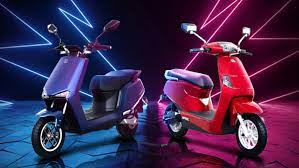The electric two-wheeler industry in India is poised for a transformative future as the country accelerates its transition toward sustainable transportation. With increasing awareness about environmental concerns, rising fuel costs, and government initiatives to promote electric mobility, the stage is set for a remarkable growth trajectory for electric two-wheelers in India. Let's explore the key factors that shape the future of the electric Scooter two-wheeler industry in India.
- Evolving Technology: As technology continues to advance, the future of electric two-wheelers holds exciting prospects. Battery technology, a crucial component of electric vehicles, is undergoing rapid development. Lithium-ion batteries are becoming more efficient, compact, and affordable, resulting in increased range and shorter charging times for electric scooters. Moreover, advancements in electric motor technology are enhancing performance and delivering a more enjoyable riding experience. As technology progresses, electric two-wheelers will become more capable, efficient, and cost-effective.
- Government Support and Policies: The Indian government has been actively promoting electric mobility through various policies and initiatives. The FAME (Faster Adoption and Manufacturing of Electric Vehicles) scheme offers financial incentives to manufacturers and buyers, making electric two-wheelers more accessible and affordable. Additionally, state governments are implementing their own policies, such as subsidies and tax incentives, to encourage the adoption of electric vehicles. The continued support and commitment of the government will play a crucial role in shaping the future of the electric two-wheeler industry in India.
- Infrastructure Development: The availability of a robust charging infrastructure is vital for the widespread adoption of electric two-wheelers. To address this, the government and private players are investing in the development of charging stations across the country. Additionally, innovative solutions like battery-swapping infrastructure are being explored to overcome the limitations of charging time. As the charging infrastructure expands and becomes more accessible, range anxiety will reduce, encouraging more consumers to switch to electric two-wheelers.
- Affordability and Cost Parity: Affordability has been a key consideration for Indian consumers, and the electric two-wheeler industry is gradually approaching cost parity with conventional internal combustion engine (ICE) vehicles. Decreasing battery costs, economies of scale, and advancements in manufacturing processes are driving down the prices of electric two-wheelers. As the price gap between electric and conventional scooters narrows, electric two-wheelers will become a compelling choice for cost-conscious consumers.
- Growing Consumer Demand: There is a significant and growing demand for electric two-wheelers among Indian consumers. The increasing awareness about environmental sustainability, coupled with rising fuel prices, is driving the adoption of electric vehicles. Electric two-wheelers provide a practical and economical solution for urban commuting, offering lower operating costs and reduced environmental impact. As more consumers recognize the benefits of electric two-wheelers, the demand will continue to soar, leading to greater market penetration and industry growth.
- Technological Innovations and Features: The future of electric two-wheelers in India will witness significant technological innovations and the incorporation of advanced features. Electric scooters will continue to evolve with enhanced connectivity options, digital displays, and smart features. Additionally, IoT (Internet of Things) integration and vehicle-to-grid (V2G) capabilities will enable seamless integration with smart cities and energy management systems. These advancements will not only improve the user experience but also facilitate the integration of electric two-wheelers into the larger transportation ecosystem.
- Market Competition and Product Diversity: With the growing demand for electric two-wheelers, the market will witness increased competition among manufacturers. Established players and startups will continue to introduce new models with diverse designs, features, and price points to cater to the varied needs and preferences of consumers. This competition will drive innovation and push manufacturers to improve the quality, performance, and affordability of electric two wheelers. The availability of a wide range of options will empower consumers to choose electric two-wheelers that best align with their requirements, further accelerating the adoption of electric mobility.
- Integration with Renewable Energy: As India strives to increase its renewable energy capacity, the integration of electric two-wheelers with clean energy sources holds immense potential. Electric scooters can act as storage devices, allowing for the utilization of excess renewable energy during peak generation times. This integration will not only enhance the environmental benefits of electric two-wheelers but also contribute to a more reliable and sustainable energy grid.
- Shift towards Shared Mobility: The rise of shared mobility services presents an exciting opportunity for electric two-wheelers. With the growth of ride-sharing and bike-sharing platforms, electric scooters can play a significant role in providing convenient and eco-friendly transportation solutions. Shared electric two-wheelers can help reduce traffic congestion, emissions, and the overall cost of mobility for users. As the sharing economy continues to expand, electric two-wheelers are expected to play a crucial role in shaping the future of urban transportation.
- Export Potential: India's electric two-wheeler industry has the potential to become a global player in the coming years. As other countries embrace electric mobility, Indian manufacturers can leverage their expertise, manufacturing capabilities, and cost advantages to export electric two-wheelers to international markets. This would not only contribute to the growth of the industry but also boost India's position as a global hub for electric vehicle manufacturing.
In conclusion, the future of the electric two-wheeler industry in India looks promising. Technological advancements, government support, infrastructure development, and changing consumer preferences are driving the rapid growth of electric two-wheelers. With increasing affordability, expanding charging infrastructure, and a wide range of product offerings, electric two-wheelers are poised to revolutionize the Indian transportation landscape. As the industry continues to innovate and address consumer needs, electric two-wheelers will play a pivotal role in creating a sustainable, clean, and efficient mobility ecosystem in India.





Comments